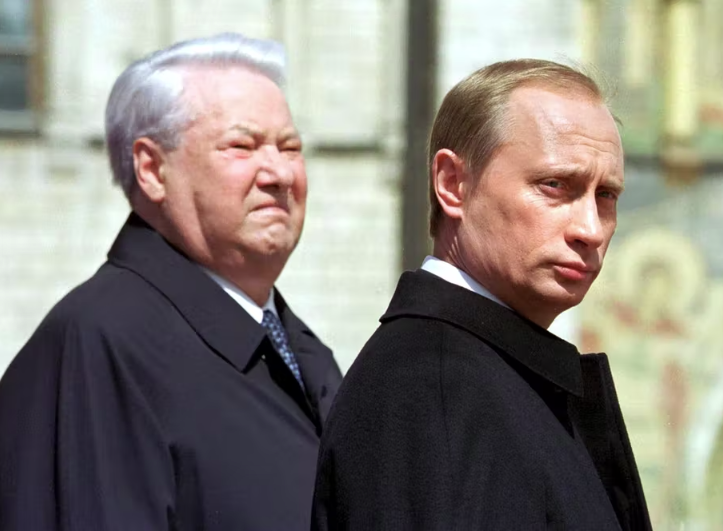 Boris Yeltsin and Vladimir Putin at Putin's inauguration in 2000. Itar-Tass Pool/EPA.
Boris Yeltsin and Vladimir Putin at Putin's inauguration in 2000. Itar-Tass Pool/EPA.
The 1990s to Today: How Privatization Shaped Modern-day Russia
The 1990s are remembered as a chaotic and turbulent period in Russian history. After the Soviet Union broke apart at the end of 1991, many thought capitalism and democracy would flood into Russia. However, despite efforts to bring liberalism to the country, present-day Russia is marked by an authoritarian leader, thriving organized crime, massive economic inequality, and a remarkable contempt for the West, most recently demonstrated by the invasion of Ukraine. How is it possible that Russia in 1992, full of opportunity and hope, became the Russia we know in 2022? The answer lies in the privatization process used by the Russian government (and advocated for by the American advisors who helped them). Overall, the Russian government failed to implement protections, regulations, and a capitalist culture before attempting to privatize, leading to a chaotic and dangerous situation that allowed for “crony capitalism” and the rise of Vladimir Putin.
The first misstep of the newly constituted Russian Federation was the decision to transition to a market economy without the necessary institutional foundation. When the USSR dissolved, the economic infrastructure of Russia went with it. Consequently, there were no regulations or protections for new private businesses. Without protection, citizens lacked incentives to invest because there was no guarantee a business would be protected from the rising presence of the Russian mafia or government corruption.
Similarly, Russia lacked the necessary culture for a market economy to function. Although many of the American advisors believed an inner capitalist, or ‘economic man,’ would emerge, this belief was unfounded. Market economies, just like planned economies, are learned by the citizens and are not an inherent part of human nature. Because the Russian economy functioned as a planned economy for seventy years, and only had a brief interlude of capitalism after the abolishment of feudalism in 1876, Russian citizens lacked an “accepted code of business behavior,” or a capitalist culture. Therefore, the development of capitalism and privatization in Russia was inhibited by mass confusion, illegal dealings, and a lack of faith and confidence.
Without these economic institutions or capitalist culture, the privatization process was chaotic and lead to massive inequality. In an attempt to mitigate this, the Russian government first decided to pursue a process called “shock therapy,” a series of rapid reforms aimed at economic liberalization, stabilization, and privatization to open the economy to international trade and investment. Those advising the Russian government at the time thought this was the only feasible solution in the face of a deepening economic crisis. However, the resulting period of hyperinflation decimated the Russian economy and depleted the savings of ordinary Russians. Following the failed shock therapy experiment, the government used a voucher system to transfer the state-owned assets to private hands. In 1992, 98% of Russian citizens received a paper “voucher” representing their share of the Soviet economy. However, the lack of economic institutions and capitalist culture meant these vouchers were viewed as worthless by many Russian citizens. This allowed a handful of citizens to amass thousands of vouchers, either taking the ones being given away for free or buying them at a nominal cost. Their accumulation of vouchers privileged well-placed Russians when the government began to auction off shares of state-owned industries. Additionally, these auctions were ostensibly open to the public, however, in reality they were largely underpublicized and often took place in remote areas. This allowed those who had amassed thousands of vouchers to collude and buy state-owned assets at low prices, thus further enshrining their status in the Russian economy and becoming what we know today as the original Russian oligarchs.
Finally, the relationship between the oligarchs and the Russian government was solidified in the mid-1990s with the “loans for shares” program. Low on cash and facing an upcoming election, the Russian government turned to the newly “anointed” oligarchs for financing. The government “loaned” Russia’s wealthy shares in 12 major state-owned businesses in exchange for money, around $800 million in total. The loans for shares scheme established the mutually beneficial and symbiotic relationship between the Russian government and the oligarchs that continues to this today.
While the oligarchs were strengthening their place at the top of the Russian economy, average Russian citizens were experiencing the first-hand effects of hyperinflation, a rise in organized crime, and a decrease in state protections. Crime rates and inequality rose, life expectancy fell, and democracy and capitalism were failing to take root. From this chaos, Vladimir Putin rose to power and became President of Russia at the turn of the 21st century. Since then, Putin has been attributed with bringing stability back to Russia after the turbulent decade of attempts at democracy and capitalism.





